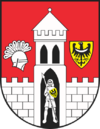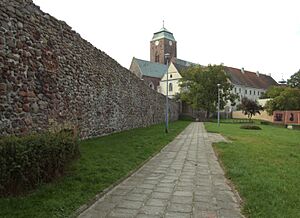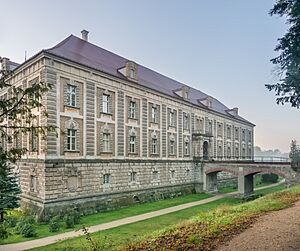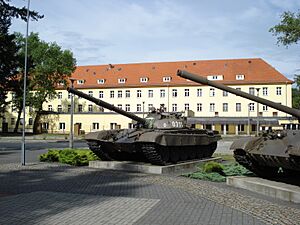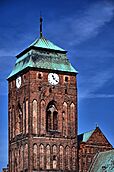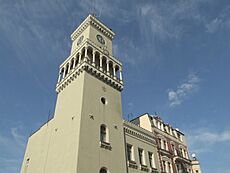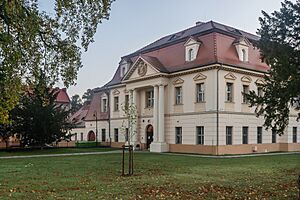Żagań facts for kids
Quick facts for kids
Żagań
|
|||
|---|---|---|---|
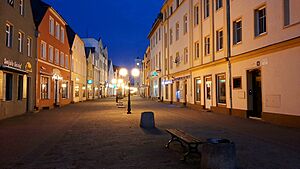
Old town
|
|||
|
|||
| Country | |||
| Voivodeship | |||
| County | Żagań | ||
| Gmina | Żagań (urban gmina) | ||
| Established | 12th century | ||
| First mentioned | 1202 | ||
| Town rights | between 1248 and 1260 | ||
| Area | |||
| • Total | 39.92 km2 (15.41 sq mi) | ||
| Population
(2019-06-30)
|
|||
| • Total | 25,731 | ||
| • Density | 644.56/km2 (1,669.41/sq mi) | ||
| Time zone | UTC+1 (CET) | ||
| • Summer (DST) | UTC+2 (CEST) | ||
| Postal code |
68-100 to 68-103
|
||
| Area code(s) | +48 68 | ||
| Car plates | FZG | ||
Żagań is a town in western Poland. It is located on the Bóbr river. About 25,731 people lived there in 2019.
Żagań is the main town of Żagań County. It is part of the historic region called Silesia. Since 1999, Żagań has been in the Lubusz Voivodeship.
The Polish 11th Armoured Cavalry Division is based in Żagań. American soldiers also visit the town as part of Operation Atlantic Resolve.
Contents
What Does the Name Żagań Mean?
The name Żagań probably means "place of the burnt forest." This might refer to early settlers burning down forests to clear land. Other nearby towns like Żary and Zgorzelec have similar names.
Where is Żagań Located?
Żagań is about halfway between the cities of Cottbus and Wrocław. It is about 100 meters above sea level. The town is roughly 100 kilometers (62 miles) north of the Czech Republic border. It is also about 40 kilometers (25 miles) east of the German border.
The countryside around Żagań is called the rural district of Żagań. The Bóbr and Kwisa rivers meet just outside the town.
A Look Back: The History of Żagań
How Żagań Began: The Polish Piast Dynasty
The area where Żagań is located was part of Poland in the 900s. Żagań was founded in the 1100s by a Polish ruler named Bolesław IV the Curly. He built it near an older settlement, which was then called Stary Żagań ("Old Żagań").
The town was first mentioned in a document from 1202. At that time, it was part of the Duchy of Silesia. This duchy was ruled by Duke Henry I the Bearded.
In 1251, Żagań became part of the new Duchy of Głogów. Duke Konrad I gave Żagań town rights between 1248 and 1260. The town grew rich from mining. Many German settlers came to live there.
After Konrad's death in 1274, his sons divided the duchy. Żagań Castle became the home of his youngest son, Przemko of Ścinawa. Przemko started a monastery for the Augustinian Canons. This is how the Duchy of Żagań began.
Later, in 1329, the dukes of Żagań became loyal to John of Bohemia, the King of Bohemia. In 1393, Henry VI the Elder died without children. The area then joined with Głogów again. In 1412, Jan I became the sole ruler of the Żagań duchy.
Changes in Rule: Saxon, Habsburg, and Prussian Times
After some fighting, Jan II the Mad sold Żagań to Duke Albert III of Saxony. This ended hundreds of years of rule by the Piast family.
In 1549, Żagań was given to King Ferdinand I of Habsburg of Bohemia. Later, in 1627, Emperor Ferdinand II gave it to Albrecht von Wallenstein. He was a top commander during the Thirty Years' War.
The town then passed to the Lobkowicz family from Bohemia. They built the beautiful Baroque Żagań Palace. In the 1700s, an important road between Warsaw and Dresden went through Żagań. Polish Kings Augustus II the Strong and Augustus III of Poland used this road often.
After the Silesian Wars in 1742, Żagań became part of Prussia. It was part of the Prussian province of Silesia. After 1871, it became part of Germany. Even in the 1800s, Żagań was still an important Polish center.
In 1786, Peter von Biron, Duke of Courland bought Żagań. In 1843, his daughter Dorothea inherited it. She was married to Edmond de Talleyrand. She spent her later years in Żagań. In 1845, the King of Prussia made her Duchess of Sagan.
Żagań During World War II
The title of "duc de Sagan" helped the duke stay neutral during World War II. His castle in France, Château de Valençay, became a safe place for treasures from the Louvre museum. This happened during the German occupation of France.
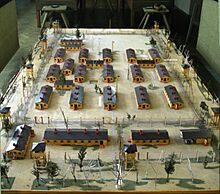
During World War II, the Germans ran two prisoner-of-war camps in Żagań. They also had a forced labor camp. These camps held prisoners from many different countries. It is thought that about 120,000 prisoners died from hunger, sickness, and bad treatment.
In February 1945, Soviet troops took over Żagań after several days of heavy fighting.
The Great Escape from Stalag Luft III
In March 1942, a special camp for captured Allied pilots was built in Żagań. It was called Stalag Luft III. This camp was the site of a very famous escape.
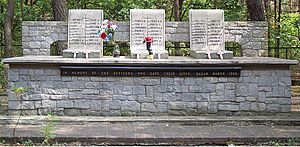
On the night of March 24, 1944, 76 Allied airmen escaped from Stalag Luft III. This event is known as "The Great Escape." It was the largest escape of officer aircrew during the war.
Out of the 76 who escaped, 73 were caught. Sadly, 50 of them were killed by the Germans on Hitler's orders. Only three men successfully got away. One reached Gibraltar, and two made it to Sweden. All three later met up in England.
Among the 50 killed were several Polish flight officers. These brave men included Major Antoni Kiewnarski, Lieutenant Stanisław Król, and navigation Lieutenants Włodzimierz Kolanowski, Jerzy Mondschein, Kazimierz Pawluk, and Paweł Tobolski.
This amazing story was made into a famous movie in 1963 called The Great Escape, starring Steve McQueen.
Żagań in Modern Poland
After Germany lost World War II, Żagań became part of Poland again. This was decided at the Potsdam Conference. The German people living in Żagań were moved out. Polish people, many from areas of Poland taken by the Soviet Union, moved into the town.
The town was rebuilt starting in 1947. New businesses, factories, and schools were opened. In the 1970s, a "new town" area was built. By 1983, the historic Żagań Palace was fully restored.
For many years, Soviet Air Forces used the town's airbase. In 1992, the last Soviet unit left.
A museum about the history of the Stalag VIII-C POW camp was opened between 1967 and 1971. In 2011, the old Augustinian monastery and church were named a Historic Monument of Poland. In 2013, the first Polish monument to Wojtek the Bear was unveiled in Żagań. Wojtek was a famous bear who was a soldier with the Polish Army in World War II.
What to See: Sights and Monuments in Żagań
- Baroque Ducal Palace: A beautiful old palace.
- Palace Park: A large park around the palace.
- Post-Augustinian Monastery Complex: This includes the Church of the Assumption. It is a burial place for the Piast dynasty rulers. It is also an official Historic Monument of Poland.
- Post-Franciscan Monastery: With the Saints Peter and Paul church.
- Town Hall: The historic building where the town government works.
- Museum of the World War II POW Camp: Learn about the prisoner-of-war camps and "The Great Escape."
- Monument of Wojtek the Bear: A statue of the famous bear soldier from World War II.
- Post-Evangelical Church Tower: An old church tower.
- Medieval Town Walls: Parts of the old walls that once protected the town.
Sports in Żagań
Żagań has several sports clubs:
- Czarni Żagań: A football (soccer) club. They were Polish Cup runners-up in 1964–65.
- WKS Sobieski Żagań: A volleyball club.
- KS Bóbr Żagań: A club for volleyball and rugby.
- UKS Orzeł Żagań: A youth unihockey club.
How to Get There: Transport in Żagań
Main Roads Through Żagań
![]() Voivodeship road 296
Voivodeship road 296 ![]() Voivodeship road 295
Voivodeship road 295 ![]() National road 12
National road 12
Important Roads Near Żagań
![]() National road 27
National road 27 ![]() National road 18
National road 18 ![]()
![]() Motorway A18 / E 36
Motorway A18 / E 36 ![]()
![]() Motorway A4 / E 40
Motorway A4 / E 40 ![]()
![]() Expressway S3 / E 65
Expressway S3 / E 65
Famous People from Żagań
- Johannes Kepler (1571–1630): A German astronomer and mathematician who lived in Żagań.
- Albrecht von Wallenstein (1583–1634): A duke of Żagań.
- Johann Ignaz von Felbiger (1724–1788): An educational reformer and abbot in Żagań.
- Peter von Biron (1724–1800): A duke of Żagań.
- Louis XVIII (1755–1824): A future king of France who visited Żagań.
- Stendhal (1783–1842): A French writer who spent time in Żagań.
- Dorothea de Talleyrand-Périgord (1793–1862): A princess of Żagań.
- Adolf Engler (1844–1930): A German botanist.
- Reinhold Röhricht (1842–1905): A German historian who studied in Żagań.
- Wolfgang Paalen (1905–1959): An Austrian painter who spent part of his childhood near Żagań.
- Bronisława Wajs (1908–1987): A Polish-Romani poet who lived in Żagań.
- Wolfgang Samuel (born 1935): An author and U.S. Air Force pilot.
- Ilse Kokula (born 1944): An educator and activist.
- Mariusz Jurasik (born 1976): A handball player.
- Łukasz Garguła (born 1981): A footballer.
- Konrad Michalak (born 1997): A footballer.
Żagań's Sister Cities
Żagań is twinned with these cities:
 Duns, Scotland, United Kingdom
Duns, Scotland, United Kingdom Netphen, Germany
Netphen, Germany Ortrand, Germany
Ortrand, Germany Saint-Omer, France
Saint-Omer, France Teltow, Germany
Teltow, Germany Khotyn, Ukraine
Khotyn, Ukraine
Cool Facts About Żagań
- Johannes Kepler started writing an early science fiction story called Somnium (novel) before he died in 1630.
- In 1769, one of the first lightning rods in Europe was put on the Church of the Assumption in Żagań.
See also
 In Spanish: Żagań para niños
In Spanish: Żagań para niños



